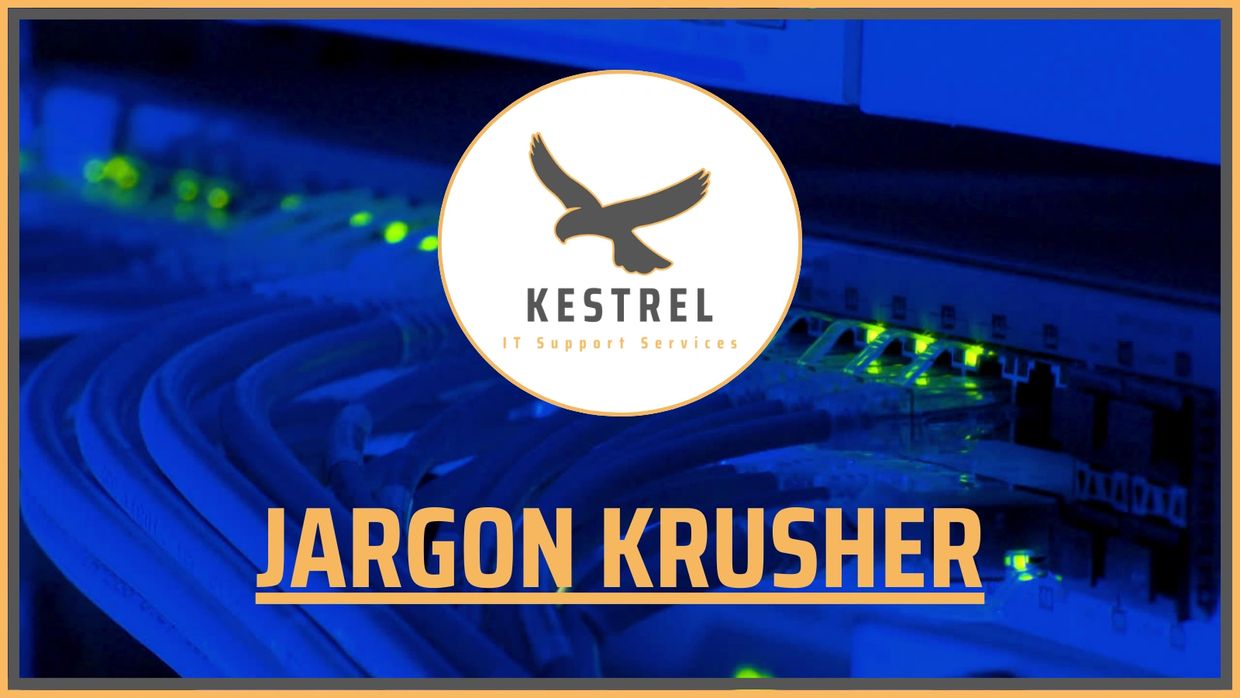Glossary of key technical terms

The purpose of this page
Introducing the Jargon Krusher! At Kestrel IT Support, we understand that navigating the world of technology can sometimes feel like learning a new language. That's why we've created this comprehensive glossary to outline common IT technical terms and concepts in the simplest way possible.
Whether you're a business owner, someone seeking IT support, or just curious, our goal is to empower you with the knowledge needed to make informed decisions about your IT infrastructure. From ‘cookies’ to ‘firewalls’, ‘APIs’ to ‘servers’, we've got you covered. Whether you're troubleshooting an issue, exploring new technologies, or simply looking to expand your IT vocabulary, let our glossary be your guide. Feel free to reach out to us if you have any questions or need further assistance. Let’s get started:
The Kestrel IT Jargon Krusher!
Cybersecurity
Firewall:
A security system that monitors and controls incoming and outgoing network traffic based on predetermined security rules.
Malware:
Malicious software designed to disrupt, damage, or gain unauthorised access to a computer system.
SSL (Secure Sockets Layer):
A protocol that provides secure communication over the internet by encrypting data transmission.
VPN (Virtual Private Network):
A secure network connection that allows users to access and transmit data over a public network as if they were directly connected to a private network.
Networking
Bandwidth:
The amount of data that can be transferred in a given amount of time, often used to describe internet speed.
DNS (Domain Name System):
A system that translates domain names (e.g., example.com) into IP addresses, allowing users to access websites using human-readable names.
IP Address (Internet Protocol Address):
A unique numerical label assigned to each device connected to a computer network, used for identification and communication.
IPv6 (Internet Protocol version 6):
The most recent version of the Internet Protocol, which provides a larger address space than IPv4 to accommodate the growing number of devices connected to the internet.
LAN (Local Area Network):
A network that connects computers and devices in a limited geographical area, such as a home, office, or school.
Protocol:
A set of rules or standards that govern communication between devices on a network.
Redundancy:
Duplication of critical components or systems in a network or computer infrastructure to ensure reliability and fault tolerance.
Web Technologies
API (Application Programming Interface):
A way for different software applications to communicate and share information with each other.
Cookie:
A small piece of data stored on a user's computer by a website, used to remember preferences and track user activity.
HTML (Hypertext Markup Language):
The standard markup language used to create web pages and applications.
URL (Uniform Resource Locator):
The address used to locate a resource, such as a website, on the internet.
Software Development
BIOS (Basic Input/Output System):
Software stored on a computer's motherboard that controls the hardware and initialises the system during start-up.
GUI (Graphical User Interface):
A visual way for users to interact with electronic devices using graphical icons, buttons, and menus.
IDE (Integrated Development Environment):
A software application that provides comprehensive tools and features for software development in one cohesive interface.
Data Management
Cache:
A storage area that stores frequently accessed data for quicker access.
Metadata:
Data that provides information about other data, such as the author, date created, or file size.
Cloud Computing
Cloud Computing:
Using remote servers accessed over the internet to store, manage, and process data rather than on a local server or personal computer.
Load Balancing:
The distribution of network traffic or computing workload across multiple servers to ensure no single server is overwhelmed, improving performance and redundancy in a cloud environment.
Business and Customer Relationship
CRM (Customer Relationship Management):
Software used to manage interactions and relationships with customers and potential customers.
Ticketing System:
A software tool used in IT support to manage and track the status of user requests or reported issues. It helps streamline communication and resolution processes within a support team.
Security and Encryption
Encryption:
The process of converting data into a code to prevent unauthorised access, making it readable only to those with the decryption key.
Two-Factor Authentication (2FA):
A security process in which a user provides two different authentication factors to verify their identity, typically something they know (password) and something they have (security token or mobile device).
System and Infrastructure:
Server:
A computer or software that provides data or services to other computers or devices on a network.
Latency:
The time delay between the initiation of a task and the response or completion of that task.
Open Source:
Software whose source code is freely available and can be modified and redistributed by anyone.
Remoting In:
Refers to the process of accessing and controlling a computer or device from a remote location. This capability is commonly used for troubleshooting technical issues, accessing files or applications on a distant computer, or providing remote support to users.
Contact Us
Kestrel IT
BL2 3EU, Bolton, Greater Manchester, England, United Kingdom